中国传统文化--风筝
风筝文化的传承与发展

风筝文化的传承与发展一、引言风筝是中国传统文化中的重要组成部分,自古以来就有着悠久的历史和深厚的文化内涵。
风筝不仅是一种娱乐活动,更是一种艺术表现形式和民间文化遗产。
本文将探讨风筝文化的传承与发展。
二、风筝文化的历史1. 风筝起源据考证,中国的风筝起源可以追溯到3000多年前的商朝时期。
当时人们用竹子、纸张等材料制作出简单的飞行器,用于军事监视和祭祀活动中。
2. 风筝发展随着时间推移,风筝逐渐演变成为一种娱乐活动,并且在唐代达到了顶峰。
唐代诗人白居易曾写下“空中楼阁七百重,底下明镜一池空”的著名诗句,形容了当时人们对于高空飞行的向往。
3. 风筝衰落到了明清时期,由于社会政治经济环境的变迁以及科技进步等原因,风筝逐渐衰落。
直到20世纪初,随着西方文化的传入和现代科技的发展,风筝再次受到青睐。
三、风筝文化的内涵1. 艺术表现形式风筝不仅是一种娱乐活动,更是一种艺术表现形式。
制作精美的风筝可以被视为艺术品,具有观赏价值。
2. 民间文化遗产风筝作为中国传统文化中的一部分,承载了丰富的民间文化遗产。
不同地区、不同民族制作的风筝各具特色,反映了当地人民的生活、信仰和审美情趣。
3. 文化交流与传播风筝在历史上曾经通过海上丝绸之路和陆上丝绸之路等途径传播到国外。
如今,在国际性的各种比赛中,中国制作的风筝也广受欢迎。
这种文化交流和传播有助于促进不同国家之间的相互了解和友谊。
四、风筝文化的传承与发展1. 传承目前,许多地方都设立了风筝博物馆或者风筝文化中心,用于收藏和展示各种风筝作品,同时也开展了一系列的风筝制作和表演活动,以便更好地传承和发扬风筝文化。
2. 发展随着社会的进步和科技的发展,现代化的风筝也应运而生。
电动风筝、遥控风筝等新型产品不仅让传统的风筝制作技艺得到了传承和发展,同时也为人们带来了更多的娱乐方式。
五、结语总之,风筝文化是中国传统文化中不可或缺的一部分。
我们应该积极参与到风筝文化的传承与发展中来,并且通过这种方式向世界展示中国优秀的民间文化遗产。
风筝文化

风筝起源于中国,又名纸鸢。
在民间通过以吉语、神话故事、历史典故为题材,用借喻、比拟、象征等表现手法在风筝上设计图案,传达和承载了人们对美好生活的祈愿。
中国风筝已有两千多年的历史。
作为一种文化一种民间艺术,自然也有它的流派。
我国地域辽阔,风筝的种类、样式繁多,千姿百态,风筝的特色与地域文化息息相关。
在潍坊风筝中最具代表性的风筝分别为龙头蜈蚣风筝,硬翅人物类风筝等。
北京风筝基本形式有硬翅、软翅、拍子、长串和桶形五种。
天津风筝在继承传统制作技术的基础上,不断创新和发展,造型更加美观,彩绘更加精美,放飞晴空令人赏心悦目,又可放于室内以供观赏,是民间工艺的珍品。
风筝的吉祥意义:春节前后,南来的和风渐渐驱走了西伯利亚南下的冷空气,地表温度增高,气流上升,正是北京放风筝的好时节,久而久之人们就把风筝和春节联系在一起了。
如果注意观察,在大年初一以前,天空中绝少看到风筝,而从初二起,风筝就越飘越多了,这也算是北京春天来临的一种标志吧!放风筝的益处:制作一只绚丽多彩、新颖别致的风筝也是一种创造。
当人们眺望自己的作品摇曳万里晴空时,专注、欣慰、恬静,这种精神状态强化了高级神经活动的调节功能,促进了机体组织、脏器生理功能的调整和健全。
双目凝视于蓝天白云之上的飞鸢,荣辱皆忘,杂念俱无,与保健气功的作用异曲同工。
其效应符合传统医学的修身养性之道。
中国传统文化的断代,已经360多年。
由于我们在很长时间内不能以开阔的胸怀理解资本主义,对于资本主义文明一直保持一种强烈的警惕性,不能积极地学习西方文化那些先进成果,结果反过来损害了我民族传统文化现代化进程。
由小见大,风筝的复兴将带动我国传统文化的复兴。
将传统文化继承,吸收,创新才能将我国传统文化推陈出新。
更符合现代社会的环境,与社会发展的要求。
关于风筝的传统文化

关于风筝的传统文化
风筝作为一种传统文化元素,在许多国家和地区都有着
悠久的历史和丰富的文化内涵。
以下是关于风筝的传统文化的一些方面:
1. 历史渊源:风筝的历史可以追溯到两千多年前的中国,被认为是世界上最早的飞行器。
古代中国的风筝起初作为军事信号工具和测量风向的工具,后来逐渐发展为娱乐活动和民间艺术形式。
2. 制作工艺:风筝的制作工艺精细,通常使用竹子、纸张、丝线等材料制作。
不同地区和国家的风筝制作有各自独特的技法和样式,展现了当地的文化特色和民族艺术风格。
3. 寓意与象征:风筝在传统文化中常常具有寓意和象征意义。
它可以象征自由、希望、梦想和向上的精神追求。
在某些文化中,风筝还被视为与天空和自然元素的联系,被赋予祈福、驱邪等意义。
4. 节庆活动:许多地区都有风筝节庆活动,如中国的清明节、端午节和中秋节等,印度的孟加拉风筝节,韩国的风
筝节等。
这些活动中,人们会聚集在一起,放飞各种各样的风筝,欣赏彩色风筝在天空中飞舞的壮观景象,感受节日的喜庆氛围。
5. 艺术表现形式:风筝作为一种艺术表现形式,不仅仅是飞行工具,还被视为一种装饰艺术品。
人们会在风筝上绘制各种图案、文字、人物或动物形象,展示创意和美感。
6. 国际交流:风筝作为一种具有跨文化特点的传统文化元素,已经成为国际间的交流纽带。
世界各地的风筝爱好者经常组织风筝节、比赛和展览,分享各自的风筝制作技艺和文化传统。
风筝作为传统文化的一部分,不仅代表了人类对自然的
探索和对自由的追求,也展现了不同地区和民族的文化特色。
通过风筝,人们可以体验到传统文化的魅力,并促进文化交流和理解。
风筝文化的传承与发展

风筝文化的传承与发展引言风筝作为一种传统的娱乐工具和艺术形式,承载着丰富的文化内涵。
在中国,风筝文化有着悠久的历史,并且经过多年的发展和演变,不断吸引着人们的兴趣和关注。
本文将探讨风筝文化的传承与发展,分析其重要性,并提出相应的措施来促进风筝文化的繁荣。
一、风筝文化的历史渊源风筝作为一种传统娱乐工具,在中国已有几千年的历史。
最早关于风筝的记载可以追溯到西汉时期,而在唐朝时期,风筝已经成为了一种流行的游戏和竞技活动。
随着时间的推移,风筝逐渐融入了中国人民生活中,并成为了独特而重要的文化象征。
二、风筝文化的特点与内涵1. 艺术性风筝制作需要高度技巧和创造力。
从设计到制作再到装饰,每一个环节都需要精心的策划和处理。
风筝的形状、图案和颜色都能够展现制作者的艺术才华,同时也能够传达出丰富的情感和意义。
2. 教育意义风筝制作和飞行过程中,人们需要动手操作以及与风筝进行互动。
这种亲身参与不仅培养了人们的动手能力和创造力,还加强了人与自然之间的联系。
此外,风筝还能够培养人们的耐心和毅力,提高他们的观察力和思考能力。
3. 文化传承风筝文化是中国传统文化中重要的组成部分之一。
通过制作、展示和传播风筝,我们可以将这一独特而珍贵的文化遗产传递给后代,并使其得到继承和发展。
同时,风筝也是连接过去与现在、连接不同地区以及连接不同文化之间的桥梁。
三、挑战与机遇1. 挑战随着科技的进步和社会变迁,传统文化面临着许多挑战。
许多年轻人对于风筝文化的了解和兴趣不足,风筝制作技艺也面临着流失的风险。
此外,由于现代生活节奏加快,人们对于传统娱乐形式的需求减少,导致风筝文化的传承受到了一定的冲击。
2. 机遇然而,随着旅游业的发展和对传统文化的重视,风筝文化也面临着一些机遇。
越来越多的人开始意识到风筝文化的重要性,并积极参与到相关活动中。
此外,国际间文化交流也为风筝文化提供了更广阔的舞台,使其得以在全球范围内传播和发展。
四、促进风筝文化传承与发展的措施1. 教育推广加强对学校和社区等场所进行风筝制作技巧和知识的教育推广。
风筝在中国文化中的象征意义及其历史渊源
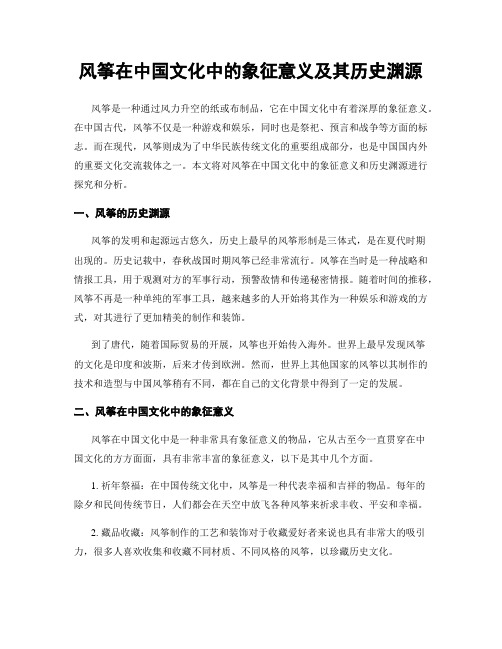
风筝在中国文化中的象征意义及其历史渊源风筝是一种通过风力升空的纸或布制品,它在中国文化中有着深厚的象征意义。
在中国古代,风筝不仅是一种游戏和娱乐,同时也是祭祀、预言和战争等方面的标志。
而在现代,风筝则成为了中华民族传统文化的重要组成部分,也是中国国内外的重要文化交流载体之一。
本文将对风筝在中国文化中的象征意义和历史渊源进行探究和分析。
一、风筝的历史渊源风筝的发明和起源远古悠久,历史上最早的风筝形制是三体式,是在夏代时期出现的。
历史记载中,春秋战国时期风筝已经非常流行。
风筝在当时是一种战略和情报工具,用于观测对方的军事行动,预警敌情和传递秘密情报。
随着时间的推移,风筝不再是一种单纯的军事工具,越来越多的人开始将其作为一种娱乐和游戏的方式,对其进行了更加精美的制作和装饰。
到了唐代,随着国际贸易的开展,风筝也开始传入海外。
世界上最早发现风筝的文化是印度和波斯,后来才传到欧洲。
然而,世界上其他国家的风筝以其制作的技术和造型与中国风筝稍有不同,都在自己的文化背景中得到了一定的发展。
二、风筝在中国文化中的象征意义风筝在中国文化中是一种非常具有象征意义的物品,它从古至今一直贯穿在中国文化的方方面面,具有非常丰富的象征意义,以下是其中几个方面。
1. 祈年祭福:在中国传统文化中,风筝是一种代表幸福和吉祥的物品。
每年的除夕和民间传统节日,人们都会在天空中放飞各种风筝来祈求丰收、平安和幸福。
2. 藏品收藏:风筝制作的工艺和装饰对于收藏爱好者来说也具有非常大的吸引力,很多人喜欢收集和收藏不同材质、不同风格的风筝,以珍藏历史文化。
3. 传统文化交流:风筝也是中国传统文化与世界文化交流的重要元素之一。
中国民间艺术家经常参加各种国际风筝节和文化艺术展览,借此机会向世界展示着中国的文化魅力。
三、不同地区风筝的制作风格在中国的不同地区,风筝制作的风格和形态也有所不同。
例如:山东的刺绣风筝最为著名,它采用鲤鱼、鸳鸯、猫头鹰、蝙蝠等生动形象的动物作为造型,又被称为“动物风筝”;江苏扬州的龙凤风筝则是堪称古老且工艺复杂的,它以龙、凤为图案,线条华丽,栩栩如生;北京的北平风筝则以简单的结构和华丽的装饰著称,它的特色在于刀法细腻,线条流畅,造型精巧。
风筝简介介绍
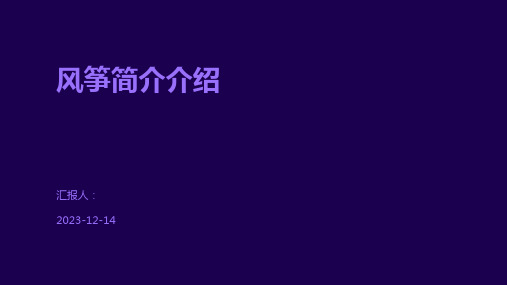
汇报人: 2023-12-14
目录
• 风筝的起源与发展 • 风筝的制作材料与工艺 • 风筝的飞行原理与技巧 • 风筝的文化内涵与价值 • 风筝的保养与收藏
01
风筝的起源与发展
风筝的起源
风筝的起源可以追溯到中国古代,据 传是由古代的发明家鲁班所发明。
随着时间的推移,风筝逐渐演变成各 种形状和大小,成为人们娱乐和竞技 的工具。
由于风筝的形状和材质,会产生向上的升力。
平衡与稳定性
02
风筝通过线与地面之间的拉力保持平衡,同时通过自身的设计
保持稳定性。
飞行高度
03
风筝的飞行高度取决于风速、风筝的设计和线长。
飞行技巧
风筝的起飞
通过奔跑或助跑将风筝拉 起,使其获得足够的速度 以产生升力。
风筝的飞行
在风筝飞行过程中,通过 控制线的松紧来调整风筝 的高度和方向。
制作工艺
1 2
骨架制作
根据设计图纸,将竹子切割成适当长度的段,然 后进行打磨和修整,确保骨架的形状和尺寸准确 无误。
蒙面制作
将纸按照设计图纸裁剪成适当的形状和大小,然 后粘贴到骨架上,确保蒙面的平整和固定风筝的各个部分,确 保风筝在飞行时的稳定性和安全性。
风筝的装饰与色彩
风筝的修复与维护
修复方法
如果风筝出现损坏或老化,可以进行修复。修复时要注意保持原貌,尽量恢复到 原有的状态。
维护建议
对于修复后的风筝,要定期进行检查和维护,确保其能够正常使用和保存。同时 ,要注意避免再次损坏。
THANKS
谢谢您的观看
风筝的艺术价值
造型艺术
风筝的造型独特,具有很高的艺术价值。它们可以是简单的几何形 状,也可以是复杂的动物或人物形象。
中国特色文化-风筝
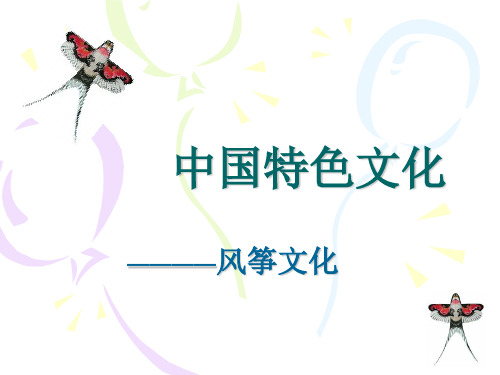
广东阳江风筝已有1400余年的历史,阳江背山面海, 旷野辽阔,到处都是天然的放飞场。
阳江市扎制的风筝,种类繁多,造型美观,技术精巧, 形神兼备,栩栩如生。不但放飞效果良好,而且形神兼备, 具有极高的实用价值、欣赏价值和收藏价值,近几年来在 全国比赛中多次名列前茅。
阳江风筝的最大特色便是“花草
祥图案与风筝有:“祥云鹤寿”,“八仙贺寿”等。
喜庆:
表达人们美好、愉快、幸福的心情。喜字有不少字形, “喜喜”是人们常见的喜庆图案。喜鹊是喜事的“征兆”, 风筝中有“喜”字风筝,“喜喜”风筝碰等,与此有关的 风筝和吉祥图案有:“喜上眉梢”,“双喜登眉”,“喜 庆有余”,“福禄寿喜”,“双喜福祥”。喜庆图案颇具 情趣的还有百蝶、百鸟、百花、百吉、百寿、百福、百喜 等图案,如“百鸟朝凤”。寓间美满婚姻、夫妇和谐有鸳 鸯图案风筝等。
憬。
中国吉祥图案内容丰富,大体有“求福”、“长寿”、 “喜庆”、“吉祥”等类型,其中以求福类图案为多。
求福:
人们对幸福有共同的追求心理。蝙蝠因与“遍福”、 “遍富”谐音,尽管它形象欠美,但经过充分美化,把它 作为象征“福”的吉祥图案。以蝙蝠为图案的风筝比比皆
如在传统的北京沙燕风筝中,以“福燕”为代表,在 整个硬膀上,可以画满经过美化的蝙蝠。其它的取其寓意 的风筝有:“福中有福”、“福在眼前”、“五福献寿”、 “五福捧寿”、“福寿双全”、“五福齐天”、“五福献 寿”等 。
• 开封风筝
开封风筝是河南开封地区传统的民间工艺品。开封风筝 历史悠久,独具特色,每年农历正月至三月的庙会上,各 式各样的风筝竞相牵放,景象十分壮观。其种类繁多,名 目各异,大致可分为“软翅”和“硬翅”两类。
软翅风筝形象生动逼真,小巧精致,玲珑可爱,多以飞 禽走兽为标本,如蝴蝶、紫燕、仙鹤、鹰、蜈蚣等。硬翅 风筝因其翅膀坚硬而得名,此类风筝一般个大,放飞时常 需数人抬搬、拉拽,场面十分壮观,标本以太极图、七星 和大脚燕为常见。
传统文化风筝介绍
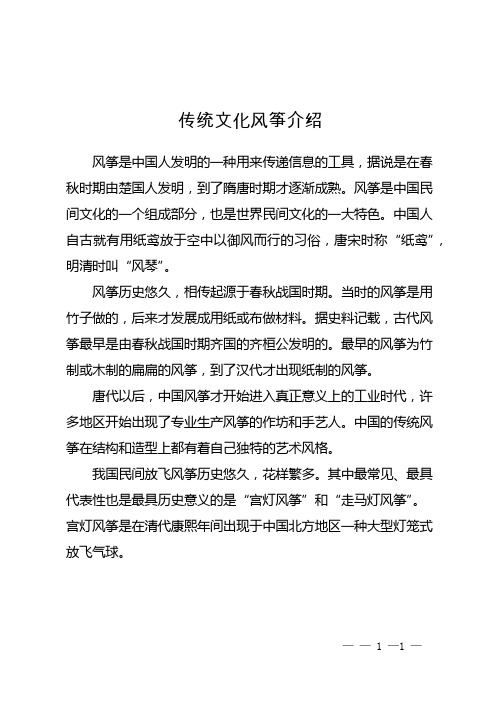
传统文化风筝介绍
风筝是中国人发明的一种用来传递信息的工具,据说是在春秋时期由楚国人发明,到了隋唐时期才逐渐成熟。
风筝是中国民间文化的一个组成部分,也是世界民间文化的一大特色。
中国人自古就有用纸鸢放于空中以御风而行的习俗,唐宋时称“纸鸢”,明清时叫“风琴”。
风筝历史悠久,相传起源于春秋战国时期。
当时的风筝是用竹子做的,后来才发展成用纸或布做材料。
据史料记载,古代风筝最早是由春秋战国时期齐国的齐桓公发明的。
最早的风筝为竹制或木制的扁扁的风筝,到了汉代才出现纸制的风筝。
唐代以后,中国风筝才开始进入真正意义上的工业时代,许多地区开始出现了专业生产风筝的作坊和手艺人。
中国的传统风筝在结构和造型上都有着自己独特的艺术风格。
我国民间放飞风筝历史悠久,花样繁多。
其中最常见、最具代表性也是最具历史意义的是“宫灯风筝”和“走马灯风筝”。
宫灯风筝是在清代康熙年间出现于中国北方地区一种大型灯笼式放飞气球。
—— 1 —1 —。
中国传统风筝

老师表示感谢!
恳请各位老师批评指正!
4
此外,风筝的绘画也是一门精 湛的技艺,画师们用笔精细, 色彩鲜明,将各种图案和寓意 融入到风筝中,使得每一只风 筝都成为了一件精美的艺术品
传承与发展
传承与发展
尽管中国传统风筝具有如此丰富的历史和文化内涵,但在现代社会中,由于种种原 因,这一古老的艺术品面临着逐渐淡出人们视线的危险。然而,随着中国文化的逐 渐复兴和传统文化的重视,中国传统风筝也正在重新获得人们的关注和喜爱
风筝的种类和特色
山东长串风筝
山东长串风筝是一种 具有代表性的山东风 筝。它以串联的形式 和响亮的哨音而闻名 ,其外形由许多形状 各异的风筝串联而成 ,像一串灯笼。长串 风筝通常带有响亮的 哨音,寓意着"一帆 风顺、事事如意"
风筝的种类和特色
四川熊猫风筝
四川熊猫风筝是一种具有代表性的四川风筝。它以可爱的形象和简洁的线条而受到喜爱, 其外形以熊猫为模板,身体圆润可爱。熊猫风筝通常带有绿色的竹子和平静的水面,寓意 着"和平安宁、幸福美满"
历史背景
1
中国传统风筝的历史可以追溯到公元前100多年 前的汉朝
2
据史书记载,汉武帝在太液池放风筝,以观看
风筝的美丽和优雅
3
此后,风筝逐渐成为中国民间文化的一部分, 并被广泛应用于军事、通讯、娱乐等领域
文化内涵
文化内涵
1
2
3
4
中国传统风筝具有丰富 的文化内涵
它不仅是一种艺术品, 更是一种文化象征和情
现在,越来越多的年轻人开始学习制作和绘制风筝,并将其作为一项文化传承和艺术创作 来追求。同时,一些地方政府和教育机构也开始重视传统文化的保护和传承工作,将风筝 制作列为非物质文化遗产的一部分,为传统风筝的传承和发展提供了更多的机会和平台
传统文化风筝作文

传统文化风筝作文传统文化风筝。
风筝是一种古老的传统文化,它既是一种娱乐方式,也是一种艺术形式。
风筝在中国已有几千年的历史,它是中国传统文化的一部分,承载着古老的智慧和文化底蕴。
风筝不仅是儿童的玩具,也是成年人的消遣,更是一种传统文化的传承和延续。
风筝最早起源于中国,据史书记载,早在春秋战国时期,风筝就已经出现在中国的民间。
风筝最初是用竹子和纸制成的,形状各异,有的像鸟,有的像鱼,有的像龙。
在古代,人们常常在风筝上写上自己的名字或寄语,然后放飞到天空中,以表达自己的愿望和心情。
风筝在中国的传统节日中也扮演着重要的角色,比如清明节时,人们会放风筝来祭奠先人,以示对逝去亲人的怀念和思念。
风筝不仅是一种玩具,更是一种艺术形式。
中国有着丰富的风筝制作技艺,不同地区的风筝各具特色,有的是精美的剪纸风筝,有的是栩栩如生的立体风筝,有的是色彩艳丽的彩绘风筝。
在中国的传统文化中,风筝被视为一种艺术品,人们常常将风筝作为礼物送给朋友或亲人,以表达自己的情感和祝福。
风筝的飞行技巧也是一门精湛的技艺,风筝爱好者常常在空旷的地方放飞风筝,以展示自己的飞行技巧和风筝的美丽。
风筝的飞行不仅需要技术,更需要耐心和毅力,只有耐心等待风筝飞到天空中,才能感受到风筝带来的快乐和美妙。
风筝是中国传统文化的一部分,它承载着古老的智慧和文化底蕴。
风筝不仅是一种娱乐方式,更是一种艺术形式,它在中国的传统节日中扮演着重要的角色,也是人们表达情感和祝福的一种方式。
风筝的飞行技巧也是一门精湛的技艺,它需要耐心和毅力,也需要对自然的敬畏和热爱。
风筝是中国传统文化的一部分,它承载着古老的智慧和文化底蕴,也是一种传统文化的传承和延续。
希望风筝这种传统文化能够被更多的人所了解和传承,让风筝的美丽和魅力得以延续下去。
关于中国非文化遗产风筝的介绍
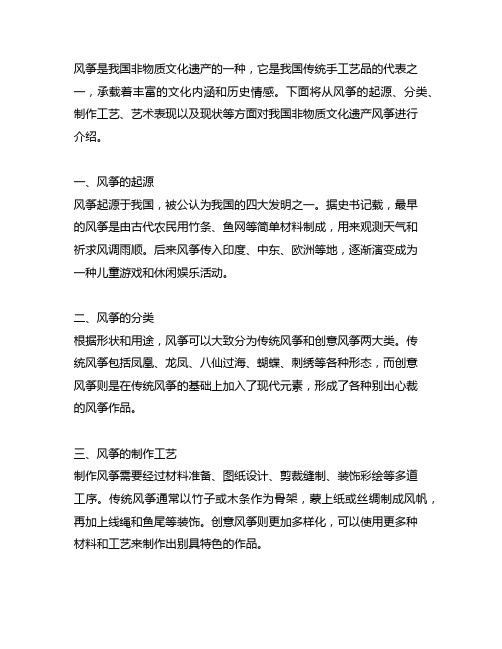
风筝是我国非物质文化遗产的一种,它是我国传统手工艺品的代表之一,承载着丰富的文化内涵和历史情感。
下面将从风筝的起源、分类、制作工艺、艺术表现以及现状等方面对我国非物质文化遗产风筝进行介绍。
一、风筝的起源风筝起源于我国,被公认为我国的四大发明之一。
据史书记载,最早的风筝是由古代农民用竹条、鱼网等简单材料制成,用来观测天气和祈求风调雨顺。
后来风筝传入印度、中东、欧洲等地,逐渐演变成为一种儿童游戏和休闲娱乐活动。
二、风筝的分类根据形状和用途,风筝可以大致分为传统风筝和创意风筝两大类。
传统风筝包括凤凰、龙凤、八仙过海、蝴蝶、刺绣等各种形态,而创意风筝则是在传统风筝的基础上加入了现代元素,形成了各种别出心裁的风筝作品。
三、风筝的制作工艺制作风筝需要经过材料准备、图纸设计、剪裁缝制、装饰彩绘等多道工序。
传统风筝通常以竹子或木条作为骨架,蒙上纸或丝绸制成风帆,再加上线绳和鱼尾等装饰。
创意风筝则更加多样化,可以使用更多种材料和工艺来制作出别具特色的作品。
四、风筝的艺术表现风筝不仅是一种实用工具,更是一种艺术表现。
在风筝的制作和装饰过程中,融入了我国传统绘画、剪纸、刺绣等工艺,使得风筝成为了一种流动的艺术品。
古代的风筝还常常配以诗词或书法,增加了艺术的内涵。
五、风筝的现状随着科技的发展和社会的变迁,传统风筝在现代已经越来越少见。
但是,在一些地方仍然保留着风筝制作的技艺,并且还有一些风筝爱好者在坚持制作和飞行传统风筝。
创意风筝因其独特的艺术魅力和装饰性,在当代也受到了越来越多的关注。
总结来说,我国的非物质文化遗产风筝,作为一种独特的手工艺品,传承了丰富的历史文化和民间艺术,具有重要的价值和意义。
相信随着人们对传统文化的重视,风筝这一传统手工艺品将会得到更好的传承和发展,为世人带来更多的欣赏和乐趣。
六、风筝的文化内涵风筝不仅仅是一种艺术品和娱乐工具,它还蕴含着丰富的文化内涵。
在我国传统文化中,风筝被赋予了许多象征意义,比如象征着人们对美好生活的向往、祈愿风调雨顺、人与自然和谐相处等。
传统风筝的知识点总结
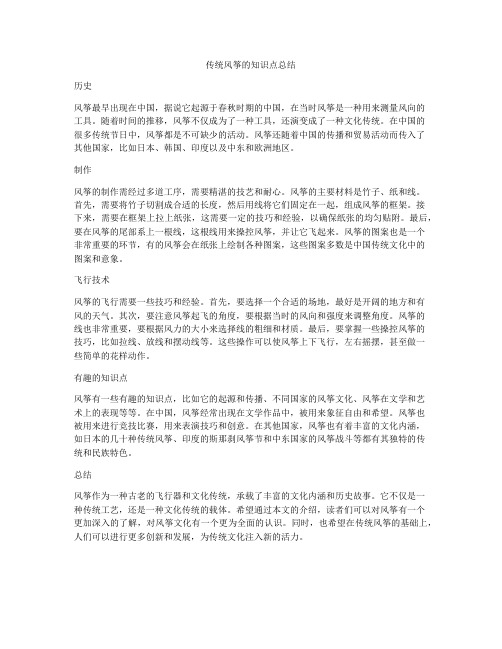
传统风筝的知识点总结历史风筝最早出现在中国,据说它起源于春秋时期的中国,在当时风筝是一种用来测量风向的工具。
随着时间的推移,风筝不仅成为了一种工具,还演变成了一种文化传统。
在中国的很多传统节日中,风筝都是不可缺少的活动。
风筝还随着中国的传播和贸易活动而传入了其他国家,比如日本、韩国、印度以及中东和欧洲地区。
制作风筝的制作需经过多道工序,需要精湛的技艺和耐心。
风筝的主要材料是竹子、纸和线。
首先,需要将竹子切割成合适的长度,然后用线将它们固定在一起,组成风筝的框架。
接下来,需要在框架上拉上纸张,这需要一定的技巧和经验,以确保纸张的均匀贴附。
最后,要在风筝的尾部系上一根线,这根线用来操控风筝,并让它飞起来。
风筝的图案也是一个非常重要的环节,有的风筝会在纸张上绘制各种图案,这些图案多数是中国传统文化中的图案和意象。
飞行技术风筝的飞行需要一些技巧和经验。
首先,要选择一个合适的场地,最好是开阔的地方和有风的天气。
其次,要注意风筝起飞的角度,要根据当时的风向和强度来调整角度。
风筝的线也非常重要,要根据风力的大小来选择线的粗细和材质。
最后,要掌握一些操控风筝的技巧,比如拉线、放线和摆动线等。
这些操作可以使风筝上下飞行,左右摇摆,甚至做一些简单的花样动作。
有趣的知识点风筝有一些有趣的知识点,比如它的起源和传播、不同国家的风筝文化、风筝在文学和艺术上的表现等等。
在中国,风筝经常出现在文学作品中,被用来象征自由和希望。
风筝也被用来进行竞技比赛,用来表演技巧和创意。
在其他国家,风筝也有着丰富的文化内涵,如日本的几十种传统风筝、印度的斯那刹风筝节和中东国家的风筝战斗等都有其独特的传统和民族特色。
总结风筝作为一种古老的飞行器和文化传统,承载了丰富的文化内涵和历史故事。
它不仅是一种传统工艺,还是一种文化传统的载体。
希望通过本文的介绍,读者们可以对风筝有一个更加深入的了解,对风筝文化有一个更为全面的认识。
同时,也希望在传统风筝的基础上,人们可以进行更多创新和发展,为传统文化注入新的活力。
中国传统文化非遗文化 风筝介绍

文 化
壹 风筝de起源
风筝最早是中国人发明de.
Chinese invented the first kite.
古时称为“鹞” yào ,北方称为“鸢” yuān.
In ancient time, kite was called “sparrow hawk" and also was well known as "glede" in northern region of China.
第贰章
风筝de用途
豪家游赏占头船,趁得风轻放纸鸢.手拍丝轮争上 下,一时回首看青天.
文 化
贰 风筝de用途
最初风筝常被利用为军事工具,用于三角测量信号、天 空风向测查和通讯de手段.
Kite was used for military purpose initially, like measuring distance and locating target, testing wind, and sending signal for communications.
中 丝 豪
轮家
国 争 游
上赏
风
. .
, ,
下占
一 时
头 船
回趁
首得
看风
青轻
天放
纸
鸢
传 统 文 化
筝
手
文
拍
化
化
文
作
制
叁筝
第风
章
How to make a kite
de
Usage of Kite
de
The Origin of Kite
de
中国传统文化风筝

文化内涵
文学艺术
风筝在中国的文学和艺术作品中也有着重要的地位。许多古代诗人和作家都曾以风筝为题材,通过描绘风筝的飞翔和形状,表达对自由、美好生活的向往。在中国的传统绘画中,风筝也是一种常见的元素,其优美的线条和丰富的色彩为画面增添了美感
文化内涵
文化内涵
地域特色
中国各地的风筝具有不同的特色和风格。北京、天津、山东等地是风筝制作的重要产地,这些地方的风筝制作技艺精湛,风格独特。其他地区如四川、广东、湖北等地的风筝也具有浓厚的地方色彩。这些不同风格的风筝反映了中国文化的多样性和丰富性
它不仅是一种玩具,更是一种艺术形式和文化符号
通过了解和传承风筝的制作技艺和文化内涵,我们可以更,具有深远的历史和文化内涵
x
-
感谢观看商业计划书模板
Simple & Creative
工作总结|工作汇报|工作计划
THANKS
不忘初心砥砺前行
风筝比赛
5
风筝比赛
如今,风筝比赛已经成为一项流行的文化活动
这些比赛不仅展示了风筝制作和放飞的技艺,也弘扬了中国传统文化
在比赛中,各种形状和风格的风筝争奇斗艳,给人们带来了视觉上的享受
通过比赛,人们也更加深入地了解了风筝的历史、文化和艺术价值
结论
6
结论
同时,通过参与风筝比赛等活动,我们也可以感受到中国文化的魅力和活力
制作技艺
4
制作技艺
制作技艺
材料选择
制作风筝的材料选择非常讲究。一般来说,竹子是制作风筝的主要材料,因为竹子具有轻盈、坚固、有韧性的特点。此外,纸张、绸缎、颜料等也常被用于风筝的制作
制作技艺
制作流程
制作风筝需要经过一系列繁琐的步骤。首先,选择合适的竹子并进行处理;然后制作风筝的骨架和尾巴;接着,将纸张或绸缎蒙在骨架上;最后,用颜料绘制图案或文字。完成后的风筝需要进行测试和调整,确保其能够在空中稳定飞翔
风筝传统文化资料

风筝传统文化资料导语:风筝是由古代劳动人民发明于中国东周春秋时期,至今已XX多年。
下面是小编收集整理的风筝传统文化资料,希望对你有帮助!中国的风筝已有二千多年的历史。
传统的中国风筝上到处可见吉祥寓意和吉祥图案的影子。
在漫长的岁月里,我们的祖先不仅创造出优美的凝聚着中华民族智慧的文字和绘画,还创造了许多反映人们对美好生活向往和追求、寓意吉祥的图案。
它通过图案形象,给人以喜庆、吉祥如意和祝福之意;它融合了群众的欣赏习惯,反映人们善良健康的思想感情,渗透着我国民族传统和民间习俗,因而在民间广泛流传,为人们喜闻见。
十三世纪时,意大利马可波罗自中国返回欧洲后,始传到世界各地。
据古书记载:“五代李郑于宫中作纸鸢,引线乘风为戏,后于鸢首以竹为笛,使风入竹,声如筝鸣,故名风筝。
”故而不能发出声音的叫“纸鸢”,能发出声音的叫“风筝”。
南北朝——风筝曾是被作为通讯求救的工具。
梁武帝时,侯景围台城,简文尝作纸鸢,飞空告急于外,结果被射落而败,台城沦陷,梁武帝饿死留下这一风筝求救的故事。
北齐——文宣帝高洋,将人绑上翅膀,令人从高塔跳下摔死,名为“生”。
汉代——楚汉相争,韩信曾令人制作大型风筝,并装置竹哨弓弦,于夜间漂浮楚营,使其发出奇怪声音,以瓦解楚军士气。
唐代——将被用于军事上的风筝,已渐转化为娱乐用途,并于宫庭中出放风筝.宋代——把放风筝做为锻炼身体的功能,百姓在清明节时,将风筝放的高而远,然后将线割断,让风筝带走一年所积之霉气。
明代——以风筝载炸药,依“风筝碰”的原理,引爆风筝上的引火线,以达成杀伤敌人之目的。
清乾隆——即有双纸控制风筝详图尺寸与解说。
日据时代——因军事的理由禁止放风筝,因为鲜艳的风筝可传递给敌方讯息,并提供飞机轰炸的目标。
18世纪,美国科学家富兰克林曾在下雨天放风筝来证实大气中含电,并由此发明了避雷针。
1915年,中国风筝第一次参加巴拿马万国博览会,北京风筝艺人哈长英、天津风筝艺人魏元泰所制作的风筝分获金牌奖和银牌奖,中国传统风筝文化更加闻名海外。
中国风筝的种类
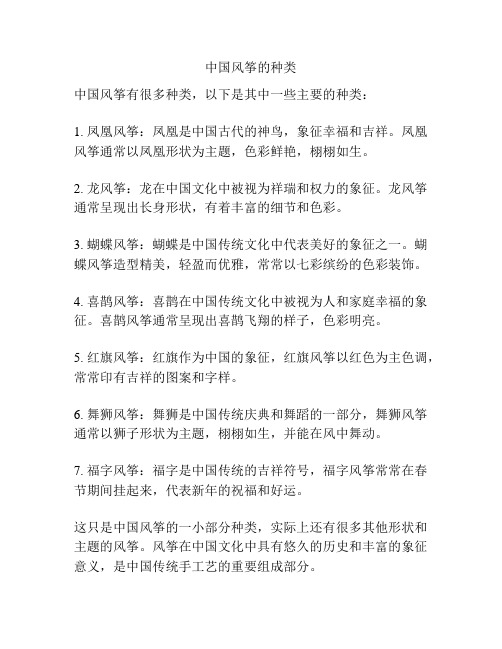
中国风筝的种类
中国风筝有很多种类,以下是其中一些主要的种类:
1. 凤凰风筝:凤凰是中国古代的神鸟,象征幸福和吉祥。
凤凰风筝通常以凤凰形状为主题,色彩鲜艳,栩栩如生。
2. 龙风筝:龙在中国文化中被视为祥瑞和权力的象征。
龙风筝通常呈现出长身形状,有着丰富的细节和色彩。
3. 蝴蝶风筝:蝴蝶是中国传统文化中代表美好的象征之一。
蝴蝶风筝造型精美,轻盈而优雅,常常以七彩缤纷的色彩装饰。
4. 喜鹊风筝:喜鹊在中国传统文化中被视为人和家庭幸福的象征。
喜鹊风筝通常呈现出喜鹊飞翔的样子,色彩明亮。
5. 红旗风筝:红旗作为中国的象征,红旗风筝以红色为主色调,常常印有吉祥的图案和字样。
6. 舞狮风筝:舞狮是中国传统庆典和舞蹈的一部分,舞狮风筝通常以狮子形状为主题,栩栩如生,并能在风中舞动。
7. 福字风筝:福字是中国传统的吉祥符号,福字风筝常常在春节期间挂起来,代表新年的祝福和好运。
这只是中国风筝的一小部分种类,实际上还有很多其他形状和主题的风筝。
风筝在中国文化中具有悠久的历史和丰富的象征意义,是中国传统手工艺的重要组成部分。
中国文化风筝介绍

中国文化风筝是一种传统手工艺品,它融合了艺术、手工艺、民俗习惯和地方文化等多种元素。
它以纸或丝作为制作材料,经过精心设计、手工制作和放飞,具有独特的艺术价值和观赏价值。
文化风筝的形状和图案各异,反映了不同地区和文化的特点。
比如在潍坊,文化风筝通常带有吉祥的图案,如鱼、莲花、鹿等,象征着吉祥、富饶和长寿。
在京津冀地区的文化风筝中,则常融入了龙、凤、狮等传统图案,体现了浓郁的民俗气息。
此外,文化风筝的制作过程也是一项复杂的手工艺。
它需要制作者对风筝的形状、结构、风向等因素有深入的了解,并经过反复试验和修改,才能制作出既美观又实用的风筝。
这个过程需要耐心、细心和创造力,也是对传统手工艺的传承和发扬。
总的来说,文化风筝不仅是一种手工艺品,更是一种地方文化的象征,它承载着人们的历史记忆、民俗传统和审美观念,具有很高的文化价值和艺术价值。
传统文化风筝作文
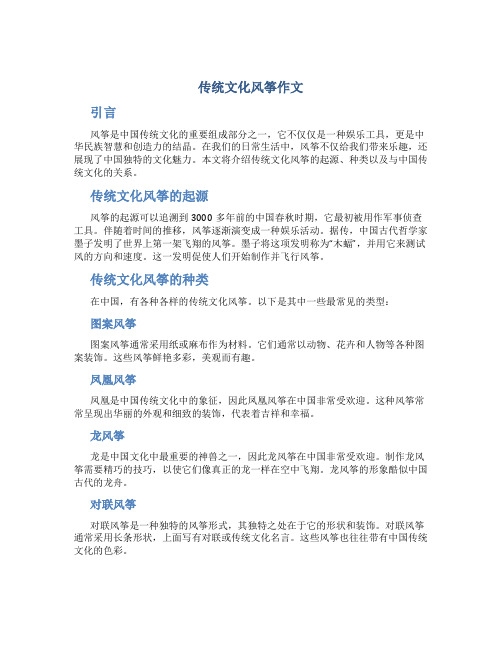
传统文化风筝作文引言风筝是中国传统文化的重要组成部分之一,它不仅仅是一种娱乐工具,更是中华民族智慧和创造力的结晶。
在我们的日常生活中,风筝不仅给我们带来乐趣,还展现了中国独特的文化魅力。
本文将介绍传统文化风筝的起源、种类以及与中国传统文化的关系。
传统文化风筝的起源风筝的起源可以追溯到3000多年前的中国春秋时期,它最初被用作军事侦查工具。
伴随着时间的推移,风筝逐渐演变成一种娱乐活动。
据传,中国古代哲学家墨子发明了世界上第一架飞翔的风筝。
墨子将这项发明称为“木蝠”,并用它来测试风的方向和速度。
这一发明促使人们开始制作并飞行风筝。
传统文化风筝的种类在中国,有各种各样的传统文化风筝。
以下是其中一些最常见的类型:图案风筝图案风筝通常采用纸或麻布作为材料。
它们通常以动物、花卉和人物等各种图案装饰。
这些风筝鲜艳多彩,美观而有趣。
凤凰风筝凤凰是中国传统文化中的象征,因此凤凰风筝在中国非常受欢迎。
这种风筝常常呈现出华丽的外观和细致的装饰,代表着吉祥和幸福。
龙风筝龙是中国文化中最重要的神兽之一,因此龙风筝在中国非常受欢迎。
制作龙风筝需要精巧的技巧,以使它们像真正的龙一样在空中飞翔。
龙风筝的形象酷似中国古代的龙舟。
对联风筝对联风筝是一种独特的风筝形式,其独特之处在于它的形状和装饰。
对联风筝通常采用长条形状,上面写有对联或传统文化名言。
这些风筝也往往带有中国传统文化的色彩。
传统文化风筝与中国传统文化的关系传统文化风筝与中国传统文化密切相关。
首先,风筝制作和飞行是中国民间传统艺术的重要组成部分。
它们不仅仅是娱乐活动,更是一种表达人们对自然和生活的热爱的方式。
其次,传统文化风筝反映了中国古代文化的特点和美学观念,如图案、绘画、文字等。
通过制作和飞行传统文化风筝,人们可以深入了解中国传统文化,并在享受乐趣的同时传承和弘扬传统文化。
结论传统文化风筝作为中国传统文化的瑰宝,具有独特的艺术魅力和文化意义。
通过制作和飞行传统文化风筝,我们可以深入了解中国古代文化和美学观念。
中国风筝的技艺概括起来只有四个字,

中国风筝的技艺概括起来只有四个字,一、风筝的概述风筝,作为一种传统的民间艺术和休闲活动,在我国有着悠久的历史。
风筝起源于春秋战国时期,历经千年的演变,逐渐形成了独特的技艺和丰富的文化内涵。
风筝不仅是一种艺术品,更是人们沟通交流、传递情感的载体。
二、中国风筝的技艺特点中国风筝的技艺概括起来只有四个字:造型优美、技艺精湛。
首先,风筝的造型丰富多样,有动物、人物、山水等,栩栩如生,富有想象力。
其次,风筝的制作工艺独具匠心,采用竹、纸、线等原材料,通过绘制、裱糊、组装等环节,构成一幅幅精美的艺术品。
三、风筝的流派与代表作品中国风筝分为四大流派:北京风筝、天津风筝、南通风筝和潍坊风筝。
各流派均有自己的特色和代表作。
如北京风筝以宫廷风筝为代表,造型大气,色彩艳丽;天津风筝以软翅风筝著称,形态各异,栩栩如生;南通风筝以板鹞风筝为主,画面宏大,富有民间气息;潍坊风筝则以硬翅风筝为代表,线条流畅,造型典雅。
四、风筝的制作与放飞技巧制作风筝的过程分为四个步骤:选材、制作骨架、裱糊和绘制。
制作过程中要注意骨架的稳定性、裱糊的平整度和绘制的艺术性。
放飞风筝时,要选择合适的场地,根据风向和风筝的特点掌握放飞技巧,使风筝在空中翱翔。
五、风筝的文化意义与传承发展风筝作为中国优秀的民间艺术,具有丰富的文化内涵和深厚的历史底蕴。
它承载着人们对美好生活的向往,传递着友谊、亲情和爱情。
如今,风筝已成为国际交流的桥梁,让更多人了解中国传统文化。
同时,我们要继续传承和发展风筝技艺,让这一优秀的民间艺术焕发出新的活力。
【总结】中国风筝作为一种传统的民间艺术,具有独特的技艺和丰富的文化内涵。
了解风筝的流派、制作技巧和放飞方法,有助于我们更好地传承和发展这一优秀的文化遗产。
- 1、下载文档前请自行甄别文档内容的完整性,平台不提供额外的编辑、内容补充、找答案等附加服务。
- 2、"仅部分预览"的文档,不可在线预览部分如存在完整性等问题,可反馈申请退款(可完整预览的文档不适用该条件!)。
- 3、如文档侵犯您的权益,请联系客服反馈,我们会尽快为您处理(人工客服工作时间:9:00-18:30)。
古时称为“鹞” yào ,北方称 为“鸢” yuān.
In ancient time, kite was called “sparrow hawk" and also was well known as "glede" in northern region of China.
春秋战国时,东周哲人墨翟(公元前478-392年), 曾“费时三年,以木制木鸢,飞升天空.”。墨子在鲁 山(今山东潍坊境内),“斫木为鹞,三年而成,飞 一日而败”。这是说墨子研究试制了三年, 终于用木板制成了一只木鸟,但只飞了 一天就坏了。墨子制造的这只“木鹞” (或“木鸢”)就是中国最早的风筝,也 是世界上最早的风筝。(约纪元前300 年左右),距今已有二千四百年。
唐代时,风筝传入朝鲜、 日本等周边国家. 十三世纪时,意大利马 可· 波罗自中国返欧后, 中国风筝始传到世界各地。
In Tang Dynasty, kite was introduced to China's neighboring countries like Korea and Japan. In 13th century, an Italian explorer Marco Polo introduced kite to Europe , and since then, kite was introduced to all over the world.
风筝的用途 Usage of Kite
最初风筝常被利用为军事工具,用于三角测量 信号、天空风向测查和通讯的手段。
Kite was used for military purpose initially, like measuring distance and locating target, testing wind, and sending signal for communications.
唐代诗人高骈写有《风筝》一诗:
“夜静弦声响碧空, 宫商信任入来风; 依稀似曲才堪听, 又被风吹别调中。”
Tang Dynasty poet Gao Pian’s poem - “Kite”:
“Strings sound the blue sky in a silent night, Wind brings tunes coming right; Vaguely resembles a melody to listen, Also it mists into breeze might.”
风筝的制作
风筝的形状: 主要是模仿大自然的生物,如雀鸟、昆虫、 动物及几何立体等; 而图案方面,主要由个人 喜好而设计,有动物、蝶、飞鸟等,琳琅种 种。风筝的建造材料除了丝绢、纸张外,还 有塑胶材料造的,骨杆有竹篾,木材及胶棒 等。源自ow to make a kite
Shapes of kite:
风筝的种类主要分为“硬 膀”和“软翅”两类, “硬膀”风筝翅膀坚硬, 吃风大,飞的高;“软 翅”风筝柔软,飞不高, 但飞的远。
There are two major types of kites - “hard-wings” and “soft-wings”. Kites with hard wings fly higher than the kites with soft wings, because hard wings can stand greater windpressure. However, the kites with soft wings fly further.
Techniques for making Traditional Chinese Kites: “Tie, Paste, Paint, Fly”
“Tie”- make a frame. Need to make it symmetrical, balance, so that both wings will receive same air pressure. Include: select, split, shape, chop, and connect; “Paste”- glue a piece of paper or silk onto the frame. Need to make it flat and neat. Include: select, cut, glue, edge check, and adjust; “Paint”- draw an image. Need to paint clear image with details, so that it can be seen from far away, and looks vivid. Include:color, background, trace, paint, and modify; “Fly”- fly a kite. Need to adjust string’s angle according to wind. Include:wind, string, release, adjust, and retrieve.
中国传统文化
THE CHINESE TRADITIONAL CULTURE
风筝
KITE
毛远洋
JOHNSON MAO
Sanlihe #3 Elementary School Beijing, China
风筝的起源 The Origin of Kite
风筝最早是中国人发明的.
Chinese invented the first kite.
风筝用细竹扎成骨架, 再糊以纸或绢,系以长 线,利用风力升入空中。
To make a kite, you need to make a frame first. Frames usually made with thin bamboo strips. Next, paste paper or silk onto frame, then tie a long thread. It flies into the sky by wind force.
在风筝的发展过程中, 具 有悠久历史的中国传统文 化开始与风筝工艺相融, 将神话故事、花鸟瑞兽、 吉祥寓意等表现在风筝 上, 从而形成了独具地方 特色的风筝文化。
Through history of kite development, Chinese traditional culture is integrated with kite craft. Chinese fairy tales, folk art, and luck characters have been used for kite designs. Therefore, an unique kite culture with Chinese characteristics has been formed.
宋张择端的《清明上河图》,宋苏汉臣的 《百子图》里都有放赐筝的生动景象。
Song Dynasty artist Zhang Zeduan demonstrated a vividly image of playing kite in the ancient time on his panoramic painting “Along the River During the Qingming Festival”; and Su Hanchen from the same period of time did the same on his painting of “Hundred Kids”.
Designs often emulate natural creatures, like insects, birds, animals and three-dimensional forms. Graphic deigns are various based on individual interests, such as promotional marks, animals, butterflies, birds, and etc. Kites are mainly made with silk, paper, and also can be made by plastic materials. Kites’ frames can be made with bamboo strips, wooden materials and glue.
据古书记载:“五代李郑于宫 中作纸鸢,引线乘风为戏, 后于鸢首以竹为,使风入 竹,声如筝鸣,故名风筝。” 故而不能发出声音的叫“纸
鸢”,能发出声音的叫“风筝”
According to an ancient books: In the period of Five Dynasties in China, Li Zheng made a kite in imperial palace. A bamboo whistle was tied to a paper kite. It made sound like Zheng (a 2125 string plucked instrument) while wind passed through. Since then, kites that could not give out sound called “paper glede”, others were called “Feng Zheng” (Feng means wind, Zheng is the music instrument).
传统的中国风筝技艺包括“扎、糊、绘、放”
“扎”即要达到对称,左右吃风面积相当, 又包括:选、劈、弯、削、接; “糊”即要保证全体平整,干净利落, 又包括:选、裁、糊、边、校; “绘”即要做到远眺清楚,近看真实的效果, 又包括:色、底、描、染、修; “放”即要依据风力调整提线角度, 又包括:风、线、放、调、收。
